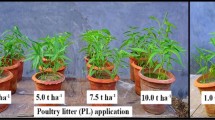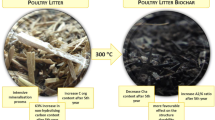Abstract
Leaching of trace metals and greenhouse plant growth (Collard greens; Brassica oleracea var. acephala) response studies were conducted in two types of soils with contrasting characteristics amended with varying rates (0 to 24.70 Mg ha−1) of poultry litter (PL) or 1:1 mixture of PL and fly ash (FA). Leaching of Cr, Zn, Cd, Cu, and Pb from soils amended with PL or PL + FA (1:1) increased with increasing rates of amendment. Leaching losses were greater from coarse-textured soil compared to that from medium-textured soil. Crop performance study indicated that growth as well as trace elements concentrations increased with increasing rates of amendments only up to 12.35 Mg ha−1. Trace element concentrations in plant parts were greater in plants grown in Candler fine sand (CFS) compared to that grown in Ogeechee loamy sand (OLS). Trace element concentrations were greater in the above ground plant parts (leaf and stem) than those in roots. This study demonstrated beneficial effects of PL or mixture of PL + FA amendments to soils at rates not exceeding 4.94 Mg ha−1. Further field studies are recommended to evaluate the long-term impact of using poultry litter and fly ash on plant growth and tissue trace metal concentration as well as environmental impact.






Similar content being viewed by others
References
Adriano, D. C. (2001). Trace elements in terrestrial environments p. 864. New York: Springer.
Adriano, D. C., Page, A. L., Elseewi, A. A., Chang, A. C., & Starnghan, I. R. (1980). Utilization and disposal of fly ash and other coal residue in terrestrial ecosystems: a review. Journal of Environmental Quality, 9, 333–344.
Alva, A. K. (1993). Copper contamination of sandy soils and effects on young Hamlin orange trees. Bulletin of Environmental Contamination and Toxicology, 51, 857–864. doi:10.1007/BF00198282.
Alva, A. K., & Graham, J. H. (1991). In J. Menon (Ed.), The role of copper in citriculture Advances in Agronomy pp. 145–170. Trivandrum: Council of Scientific Research Integration.
Alva, A. K., Sumner, M. E., & Miller, W. P. (1991). Relationship between ionic strength and electrical conductivity for soil solutions. Soil Science, 152, 239–242.
Alva, A. K., Graham, J. H., & Anderson, C. A. (1995). Soil pH and copper effects on young ‘Hamlin’ orange trees. Soil Science Society of America Journal, 59, 481–487.
Alva, A. K., Paramasivam, S., Prakash, O., Sajwan, K. S., Ornes, W. H., & van Clief, D. (1999). Effects of fly ash and sewage sludge amendments on transport of metals in different soils. In K. S. Sajwan, et al. (Ed.), Biogeochemistry of trace elements in coal and coal combustion byproducts (pp. 207–222). New York: Kluwer academic/Plenum.
Alexander, P. D., Alloway, B. J., & Dourado, A. M. (2006). Genotypic variations in the accumulation of Cd, Cu, Pb, and Zn exhibited by six commonly grown vegetables. Environmental Pollution, 144, 736–745. doi:10.1016/j.envpol.2006.03.001.
American Coal Ash Association. (2004). Annual use survey. Am. Coal Ash Assoc. Alexandria, VA.
Basta, N. T. (2000). Examples and case studies of beneficial reuse of municipal by-products. In J. F. Power, & W. A. Dick (eds.), Land application of agricultural, industrial, and municipal by-products, Soil Sci. Soc. Am., Madison, WI.
Basta, N. T., Ryan, J. A., & Chaney, R. L. (2005). Trace element chemistry in residual-treated soil: Key concepts and metal bioavailability. Journal of Environmental Quality, 33, 49–63.
Bowen, H. J. (1979). Environmental chemistry of the elements. New York: Academic.
Cabrera, M. L., & Sims, J. T. (2000). Beneficial use of poultry by-products: Challenges and opportunities. In J. F. Power & W. A. Dick (eds.). Land application of agricultural, industrial, and municipal by-products, Soil Sci. Soc. Am., Madison, WI.
Chatterjee, C., & Dube, B. K. (2005). Impact of pollutant elements on vegetables growing in sewage sludge treated soils. Journal of Plant Nutrition, 28, 1811–1820. doi:10.1080/01904160500251175.
Council of Soil Testing and Plant Analysis (1980). Handbook on Reference Methods for Soil Testing p. 89. GA: University of Georgia.
Ebbs, S. D., & Kochian, L. V. (1997). Toxicity of zinc and copper to Brassica species: Implications for phyto-remediation. Journal of Environmental Quality, 26, 776–781.
Eneji, A. E., Honna, T., & Yamamoto, S. (2001). Manuring effect on rice grain yield and extractable trace elements in soils. Journal of Plant Nutrition, 24, 967–977. doi:10.1081/PLN-100103797.
Elseewi, A. A., Straughan, I. R., & Page, A. L. (1980). Sequential cropping of fly amended soils: effects on soil chemical properties and yield and elemental composition of plants. The Science of the Total Environment, 15, 247–259. doi:10.1016/0048-9697(80)90053-4.
Food and Agricultural Organization. (1985). Guidelines for interpretation of water quality for irrigation, http://www.fao.org/docrep/T0551e04.htm.
Göthberg, A., Greger, M., Holm, K., & Bengtsson, B. E. (2004). Influence of nutrient levels on uptake and effects of mercury, cadmium, and lead in water spinach. Journal of Environmental Quality, 33, 1247–1255.
Griffin, G. P., & Jurinak, J. J. (1973). Estimation of activity coefficients from the electrical conductivity of natural aquatic systems and soil extracts. Soil Science, 116, 26–30. doi:10.1097/00010694-197307000-00005.
Gupta, G., & Charles, S. (1999). Trace elements in soils fertilized with poultry litter. Poultry Science, 78, 1695–1698.
Islam, E., Yang, X., He, Z., & Mahmood, Q. (2007). Assessing potential dietary toxicity of heavy metals in selected vegetables and food crops. Journal of Zhejiang University Science B, 8, 1–13. doi:10.1631/jzus.2007.B0001.
Jackson, B. P., Miller, W. P., Schumann, A. W., & Sumner, M. E. (1999). Trace element solubility from land application of fly ash/organic waste mixtures. Journal of Environmental Quality, 28, 639–647.
Jackson, B. P., Bertsch, P. M., Cabrera, M. L., Camberato, J. J., Seaman, J. C., & Wood, C. W. (2003). Trace element speciation in poultry litter. Journal of Environmental Quality, 32, 535–540.
John, M. K., & Van Laerhoven, C. J. (1972). Lead uptake by lettuce and oats as affected by lime, nitrogen and sources of lead. Journal of Environmental Quality, 1, 169–171.
Jones, J. B. (1972). Plant tissue analysis for micronutrients. In Mortvedt, J., Giordano, P., & Lindsay, W. L. (eds.), Micronutrients in Agriculture. Soil Sci. Soc. Am. Madison, WI. pp. 319–346.
Locascio, S. J. (1978). The relationship of copper availability and soil pH, Solutions. 30-42.
Martinez, C. E., & McBride, M. B. (1999). Dissolved and labile concentrations of Cd, Cu, Pb, and Zn in aged ferrihydrite-organic matter systems. Environmental Science & Technology, 33, 745–750. doi:10.1021/es980576c.
Martinez, V. A., & Harmel, R. D. (2006). Soil microbial communities and enzyme activities under various poultry litter application rates. Journal of Environmental Quality, 35, 1309–1318. doi:10.2134/jeq2005.0470.
Martens, D. C. (1971). Availability of plant nutrients in fly ash. Compost Science, 12, 15–19.
Minson, D. J. (1990). Forage in ruminant nutrition. San Diego: Academic.
Moore Jr, P. A., Daniel, T. C., Gilmour, J. T., Shreve, B. R., Edwards, D. R., & Wood, B. H. (1998). Decreasing metal runoff from poultry litter with aluminum sulfate. Journal of Environmental Quality, 27, 92–99.
Moss, L. H., Epstein, E., & Logan, T. L. (2002). Evaluating risks and benefits of soil amendments used in agriculture, Rep. 99-PUM-1, Water Environ. Res. Foundation, Alexandria, VA.
Naidu, R., & Harter, R. D. (1998). Effectiveness of different organic ligands on sorption and extractability of cadmium by soils. Soil Science Society of America Journal, 62, 644–650.
Nyakatawa, E. Z., & Reddy, K. C. (2002). Conservation tillage and poultry litter effects on cotton and corn yields: Five year results. In E. van Santen. (ed.), Proc. Southern Conserv. Tillage Conf. for Sustainable Agric., Auburn, AL. Spec. Rep. 1. (pp. 142–147), Alabama Agric. Exp. Stn. And Auburn Univ., Auburn, AL.
Page, A. L., Elseewi, A. A., & Stranghan, I. R. (1979). Physical and chemical properties of fly ash from coal-fired power plants with reference to environmental impacts. Residue Reviews, 71, 83–120.
Page, A. L., Logan, T. G., & Ryan, J. A. (1987). Land application of sludge. Chelsea: Lewis.
Pederson, G. A., Brink, G. E., & Fairbrother, T. E. (2002). Nutrient uptake in plant parts of sixteen forages fertilized with poultry litter: Nitrogen, Phosphorus, Potassium, Copper, and Zinc. Agronomy Journal, 94, 895–904.
Pirani, A. L., Brye, K. R., Daniel, D. C., Haggard, B. E., Gbur, E. E., & Mattice, J. D. (2006). Soluble metal leaching from a poultry litter-amended udult under pasture vegetation. Vadose Zone J, 5, 1017–1034. doi:10.2136/vzj2005.0138.
Punshon, T., & Dickinson, N. M. (1997). Acclimation of Salix to metal stress. The New Phytologist, 137, 303–314. doi:10.1046/j.1469-8137.1997.00802.x.
Qian, J. H., Zayed, A., Zhu, Y. L., Yu, M., & Terry, N. (1999). Phytoaccumulation of trace elements by wetland plants: III. Uptake and accumulation of ten trace elements by twelve plant species. Journal of Environmental Quality, 28, 1448–1455.
Ransome, L. S., & Dowdy, R. H. (1987). Soybean growth and boron distribution in sandy soil amended with scrubber sludge. Journal of Environmental Quality, 16, 171–175.
Sajwan, K. S., Ornes, W. H., & Youngblood, T. (1995). The effect of fly ash/sewage sludge mixtures and application rates on biomass production. Journal of Environmental Science and Health, 30, 1327–1337.
Sajwan, K. S., Paramasivam, S., Alva, A. K., Adriano, D. C., & Hooda, P. S. (2003). Assessing the feasibility of land application of fly ash and municipal sewage sludge and their mixtures. Advances in Environmental Research, 8, 77–91. doi:10.1016/S1093-0191(02)00137-5.
SAS. (2000). User’s Guide: Statistics, Release 8.01 edition, Statistical Analysis System Institute Inc., Cary, NC, USA.
Schroeder, P. D., Radcliffe, D. E., & Cabrera, M. L. (2004). Rainfall timing and poultry litter application rate effects on phosphorus loss in surface runoff. Journal of Environmental Quality, 33, 2201–2209.
Shankar, A. K., Cerventas, C., Loza-Tavera, H., & Avudainayagam, S. (2005). Chromium toxicity in plants. Environment International, 31, 739–753. doi:10.1016/j.envint.2005.02.003.
Sims, J. T. (1995). Characteristics of animal wastes and waste amended soils: An overview of the agricultural and environmental issues. In K. Steele (Ed.), Animal waste and the land-water interface (pp. 1–14). Boca Raton: CRC.
Tewolde, H., Sistani, K. R., & Rowe, D. E. (2005). Broiler litter as a micronutrient source for cotton: Concentrations in plant parts. Journal of Environmental Quality, 34, 1697–1706. doi:10.2134/jeq2005.0009.
USDA-NRCS. (2000). Manure nutrients relative to the capacity of crop land and pasture land to assimilate: Spatial and temporal trends for the United States, Publication no. nps 00-579, p. 18.
Van der Watt, H., Sumner, M. E., & Cabrera, M. L. (1994). Bioavailability of copper, manganese, and zinc in poultry litter. Journal of Environmental Quality, 23, 43–49.
Vasseur, L., Fortin, M. J., & Cyr, J. (1998). Clover and cress as indicator species of impacts from limed sewage sludge and landfill wastewater land application. The Science of the Total Environment, 217, 231–239. doi:10.1016/S0048-9697(98)00178-8.
Wallace, A., & Romney, E. M. (1977). Biological Implications of Metals in the Environment. In H. Drucker, & R. E. Wildung (Eds.), CONF-750929. NTIS. VA: Springfield.
Zhu, B., & Alva, A. K. (1993). Distribution of trace metals in some sandy soils under citrus production. Soil Science Society of America Journal, 57, 350–355.
Zvomuya, F., Rose, C. J., & Gupta, S. C. (2006). Nitrogen and phosphorus leaching from growing season versus year-round application of wastewater on seasonally frozen lands. Journal of Environmental Quality, 35, 324–333. doi:10.2134/jeq2005.0092.
Acknowledgement
This research was funded, in part, by (DOE and EPA) contract number DE-FG09-96SR-18558, US Department of Energy/and Environmental Protection Agency and Savannah State University. Assistance offered by Dr. Ashim Heanacho to review statistical procedures and revised version of the manuscript is highly appreciated.
Author information
Authors and Affiliations
Corresponding author
Rights and permissions
About this article
Cite this article
Paramasivam, S., Richards, K.A., Alva, A.K. et al. Evaluation of Poultry Litter Amendment to Agricultural Soils: Leaching Losses and Partitioning of Trace Elements in Collard Greens. Water Air Soil Pollut 202, 229–243 (2009). https://doi.org/10.1007/s11270-008-9972-9
Received:
Accepted:
Published:
Issue Date:
DOI: https://doi.org/10.1007/s11270-008-9972-9




